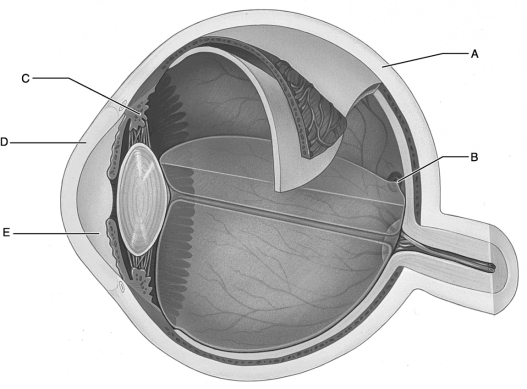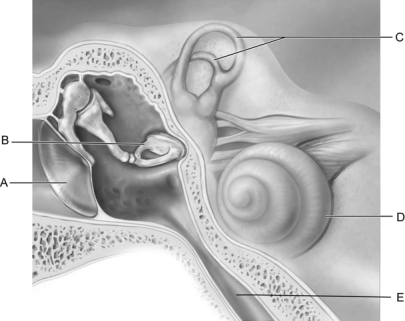B) False
Correct Answer

verified
Correct Answer
verified
Essay
Identify the relationship between olfactory receptor cells, glomeruli, and mitral cells. Then explain how odor signals are amplified to the mitral cells.
Correct Answer

verified
Odor molecules bind to olfactory recepto...View Answer
Show Answer
Correct Answer
verified
View Answer
True/False
Most of the special sensory receptors are free nerve endings.
B) False
Correct Answer

verified
Correct Answer
verified
Multiple Choice
Each of the following structures participates in bending of light entering the eye except the
A) lens.
B) vitreous humor.
C) cornea.
D) iris.
F) None of the above
Correct Answer

verified
Correct Answer
verified
Short Answer
The synapse between an olfactory neuron and a mitral cell occurs in .)
Correct Answer

verified
Correct Answer
verified
Multiple Choice
Hair cells are receptor cells for
A) both hearing and equilibrium.
B) taste.
C) smell.
D) fine touch.
F) B) and D)
Correct Answer

verified
Correct Answer
verified
Multiple Choice
In Chapter 12 on the CNS, we learned that the inferior olivary nucleus and medial lemniscus are a relay nucleus and a fiber tract in general somatic sensory pathways in the brain. The superior olivary nucleus and the lateral lemniscus are entirely different structures belonging to what sensory pathway?
A) taste
B) visual
C) olfactory
D) auditory
F) A) and C)
Correct Answer

verified
Correct Answer
verified
Multiple Choice
Which of the following membranes is not part of the cochlea?
A) basilar
B) vestibular
C) tympanic
D) tectorial
F) None of the above
Correct Answer

verified
Correct Answer
verified
Multiple Choice
The ossicle that is shaped like the stirrup of a saddle is the
A) tympanic membrane.
B) malleus.
C) stapes.
D) incus.
F) B) and C)
Correct Answer

verified
C
Correct Answer
verified
Multiple Choice
 Figure 16.2
Use the diagram above to answer the following questions.
-Identify the letter that indicates the region of the retina that contains only cones and provides maximal visual acuity.
Figure 16.2
Use the diagram above to answer the following questions.
-Identify the letter that indicates the region of the retina that contains only cones and provides maximal visual acuity.
A) A
B) B
C) C
D) D
E) E
G) C) and D)
Correct Answer

verified
Correct Answer
verified
Multiple Choice
ʺUncinate fitsʺ are characterized by
A) vertigo.
B) imaginary odors.
C) photo sensitivity.
D) auditory hallucinations.
F) B) and C)
Correct Answer

verified
B
Correct Answer
verified
Multiple Choice
Endolymph-filled structure containing receptors for hearing.
A) semicircular canals
B) vestibule
C) utricle
D) cochlear duct
E) saccule
G) A) and B)
Correct Answer

verified
Correct Answer
verified
Multiple Choice
 Figure 16.1
Use the diagram above to answer the following questions.
-Identify the letter that indicates the structure that is called the cochlea.
Figure 16.1
Use the diagram above to answer the following questions.
-Identify the letter that indicates the structure that is called the cochlea.
A) A
B) B
C) C
D) D
E) E
G) B) and D)
Correct Answer

verified
Correct Answer
verified
Multiple Choice
Receptors for hearing are located in the
A) tympanic membrane.
B) middle ear.
C) cochlear duct.
D) semicircular canals.
F) A) and C)
Correct Answer

verified
C
Correct Answer
verified
Multiple Choice
Which of the following could not be seen as one looks into the eye with an ophthalmoscope?
A) fovea centralis
B) macula lutea
C) optic chiasma
D) optic disc
F) C) and D)
Correct Answer

verified
Correct Answer
verified
Multiple Choice
The sensation of taste involves
A) photons altering pigment molecules.
B) movement of crystals embedded in gelatinous masses.
C) chemicals binding to microvilli.
D) bending of cilia.
F) A) and C)
Correct Answer

verified
Correct Answer
verified
True/False
Light entering the eye passes first to the rod and cone cells, then to bipolar cells, and finally to ganglion cells adjacent to the pigmented retina.
B) False
Correct Answer

verified
Correct Answer
verified
Multiple Choice
Ordinarily, it is not possible to transplant tissues from one person to another without rejection, yet corneas can be transplanted with impunity. This is because the cornea
A) has no blood supply, except around the periphery.
B) is exposed and easily accessible.
C) has no nerve supply.
D) is not a human structure.
F) A) and C)
Correct Answer

verified
Correct Answer
verified
Multiple Choice
 Figure 16.1
Use the diagram above to answer the following questions.
-Identify the letter that indicates the middle ear ossicle that is known as the stirrup.
Figure 16.1
Use the diagram above to answer the following questions.
-Identify the letter that indicates the middle ear ossicle that is known as the stirrup.
A) A
B) B
C) C
D) D
E) E
G) A) and D)
Correct Answer

verified
Correct Answer
verified
Multiple Choice
Which of the following areas has the highest concentration of cones?
A) the optic disc
B) the ora serrata retinae
C) the fovea centralis
D) the macula lutea
F) C) and D)
Correct Answer

verified
Correct Answer
verified
Showing 1 - 20 of 117
Related Exams